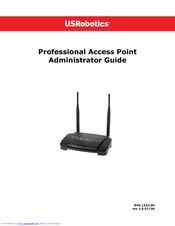US Robotics Instant802 APSDK Manuals
Manuals and User Guides for US Robotics Instant802 APSDK. We have 1 US Robotics Instant802 APSDK manual available for free PDF download: Administrator's Manual
US Robotics Instant802 APSDK Administrator's Manual (328 pages)
Professional Access Point
Brand: US Robotics
|
Category: Wireless Access Point
|
Size: 4 MB
Table of Contents
Advertisement
Advertisement
